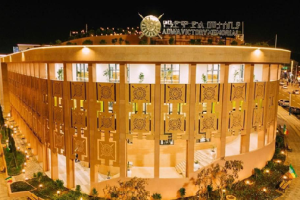
According to a recent report by Reuters news agency, entitled “After a century and a half, Ethiopian artifacts return home”, it was reported that “After a century and a half hidden in private collections, 13 stolen Ethiopian artifacts have finally returned home following months of negotiations. The report also quoted the Ethiopian tourism minister saying that, “Our country’s ancient civilization’s history, artifacts, fingerprints of indigenous knowledge, culture … have been looted in war and smuggled out illegally,”
It was also reported that, “The looted items, which include an intricately latticed processional cross, a richly colored triptych depicting Jesus’ crucifixion, and an ornate red and brass imperial shield, are part of the largest act of restitution in Ethiopia’s history,” according to Ethiopian officials.
“There are many artifacts that were looted from Maqdala,” said Teferi Meles, Ethiopia’s ambassador to the United Kingdom, where many of the treasures were. “We couldn’t manage to bring back all of them, but this is the first time in the country’s history to bring back looted artifacts in this quantity.”
Several of the objects were acquired by The Scheherazade Foundation, a cultural nonprofit, and handed to the Ethiopian embassy in September. They were returned to Addis Ababa this weekend and will go on display in Ethiopian museums. But the work is far from over, officials said.
“We have started negotiations with the British Museum to bring back 12 tabots,” said Teferi. Tabots are replicas of the Ark of the Covenant that are sacred in the Ethiopian Orthodox Church, one of the world’s oldest churches. The tabots were also taken after the Battle of Maqdala.
“We believe we will be successful in bringing them back and the negotiations will continue, with other artefacts abroad,” Teferi added.
The British Museum said it held “cordial discussions” with an Ethiopian delegation in September and noted “The Museum has long-standing and friendly relations with the National Museum in Addis Ababa and with the Ethiopian Orthodox Tewahedo Church in London and in Ethiopia.”
British museums have long resisted campaigns for the return of artworks, often citing legislation that bans them from disposing of their collections. But the debate has heated up and British Museum said last year it would loan some works from Nigeria to a new museum there due to open in 2023.
“At this moment, it is clear that our treasures are being destroyed; it is obvious our treasures are being looted and smuggled out of the country illegally,” said the Ethiopian ambassador, without offering detail.
Colonialism in Africa was a systematic assault on African cultures and heritages. This was done at two different levels. The first acts of the colonialists was to take African artifacts and cultural heritages in general to Europe and put them in the museums as testimonies of their conquests or as war booties. the second and the more dangerous motive was to deprive Africans of their cultural heritages with a view to reducing them to peoples who had no identities or civilizations and thus were no equal to Europeans.
This was apparently done in a bid to disarm Africans psychologically and rob their self-confidence and confidence as human beings, which is also a preparation for the neocolonial subjugation of Africans to this day. People who have no identity are expected to be easily subjugated to foreign domination or occupation. On the margins of these acts, there were also amateur arts and heritage hunters who stole them and sold them to prestigious European museums.
Terrorists everywhere start their campaigns by killing all the people they regard as threats to their bloody faiths or ideologies but also those who oppose their bloody c. Then they on quests resort to destroying their cultural heritages so that not only their present but also their past identities vanish from the face of the land. They want the people they kill to be deprived of the past the present and the future. In conventional warfare armies target hard as well as soft targets but they rarely resort to destroying human identities.
True, the Nazis looted artifacts from the territories they conquered and transported them to Germany as war booties. The classic Hollywood movie entitled “The Train” starring Burt Lancaster, is a stark depiction of this kind of barbarism by the Nazis and the struggle to stop them from looting artworks, paintings by European masters like Picasso and Matisse and others.
When the Nazis were defeated the artworks, they looted from museums in Paris and other European capitals were returned to their rightful owners. What differentiates the Nazis from present-day terrorists like the Islamic State or Al Qaeda, is that the former stole peoples’ cultural items and took them to their country while the latter burn or destroy them totally. While the Nazis were “civilized terrorists”, groups like ISIS are barbaric ones driven only by the instinct to kill and destroy anything that stands on their path. In modern terrorist wars, the first victims are innocent civilians and the second are artifacts and cultural heritages.
Terrorists are everywhere against culture because they are driven by hatred against civilization. They hatred is targeting human civilization wherever it is found. Their first act is to destroy the traces of culture and history that make a people great like the peoples of Iraq and Syria where terrorists started their campaigns of eradication of the identities of the people they conquered by destroying the historic sites, great museums, sculptures, statues of great statesmen and leaders of religions. By destroying these remnants of history they expect to destroy nations, peoples and their civilizations altogether.
Islamic fanatics under ISIS started their terror campaigns not only by indiscriminate killings of innocent civilians. They also started by destroying thousands of years old artifacts sheltered in museums and entire cities that bore the marks of past civilizations like in many Syrian historic cities. They bulldoze statues and monuments. They burnt books they considered inimical to their fanatical beliefs. They tried to impose their faith by force killing those who refused to succumb to their fanatical convictions.
They raped, tortured and killed women and children and turned men into slaves of the so-called Islamic state. They kidnapped women and made them sex slaves. They impregnated many of them as they were turned into sex objects to ISIS fighters. All these acts of extreme cruelty could not however satisfy their barbaric and bestial instincts. They turned their attentions to anything that bore the slightest marks of human artistic achievements and what they could not destroy they smuggled out of the countries and sold them to finance their terror campaigns.
Political fanatics too, share the same destructive instinct. In former Kampuchea or Cambodia for instance during the rise of the Khmer rouge regime in 1971, Pol Pot and his group started by liquidating all those who opposed him and then they resorted to destroying anything that reminded them of the great Khmer civilization of the past. They started from ground zero in their crazy bid to establish a classless society. The result of their madness led to the assassination of millions of innocent people whose remains are kept now in museum as reminders of what a godless fanatical communist movement did not only to human beings but also to cultural heritages that were thousands of years old.
In their blind drive to power and riches, ordinary human beings often turn into beasts that devour everything and anything they think they don’t like. There is no line dividing religious fanatics from political ones as they share the same hatred and the same instinct for destruction. Basically, there is no difference between the Nazis in Germany, ISIS in the Middle East or Pol Pot in Cambodia.
There are also those relatively “peaceful” reapers of human cultures. When European countries started their campaigns to colonize Africa, they conducted acts of thefts against the colonized peoples. They took precious cultural and historical artifacts from churches and palaces and kept them in European museums as war booties. Ironically, some of the African arts that were looted and taken to Europe gave inspirations to some of the greatest artists of the time like Pablo Picasso that gave birth to his cubist sculptures and portraits that that were inspired by traditional African masks.
According to the Reuters report we quoted above, “Ethiopia has been engaged in conflict for over a year now, with the federal government fighting the Tigray People’s Liberation Front and cultural artifacts are believed to have been damaged in the fighting. “If there is no treasure, it means there is no history; if there is no history, there is no nation,” the ambassador concluded his remarks.
The struggle to get Ethiopian historical artifacts back to their natural locations has started a long time ago. There was a national committee for the return of these items led by the late Dr. Richard Pankhurst. The committee has done commendable works in the past that led to the return of the Sebastopol canon which was taken from Maqdala during the British invasion of Ethiopia. There were also other items returned thanks to the efforts and pressure exerted by the committee.
Domestic conflicts and chaos are conducive to the theft of historic items and precious artifacts by both domestic and foreign treasure hunters. As the Ethiopian Ambassador to Britain has noted, in the ongoing conflict between the federal authorities and the TPLF, cultural items and ancient relics kept in churches and monasteries are likely to suffer theft as well as illegal transactions that might lead to transfer of the relics to third countries. It is therefore the duty of all national and international cultural organizations to pay attention to these challenges and do everything possible so that the artifacts would not fall in the wrongs hands or be transferred to other countries and get lost.
As a rule, terrorist groups do not respect peoples’ history or their heritages because what they are interested in is to destroy their identities and make them vulnerable to neocolonial diktat. What they are interested in is the looting and destructions of the heritages or their transfer to other criminal groups in return for money they use to buy weapons or conduct genocidal campaigns against the very owners of those heritages. The vicious circle has to be broken at some point and this requires the cooperation of all the local and international stakeholders interested in the preservation, repatriation or relocation of the stolen artifacts.
BY MULUGETA GUDETA
The Ethiopian Herald 28 November 2021





